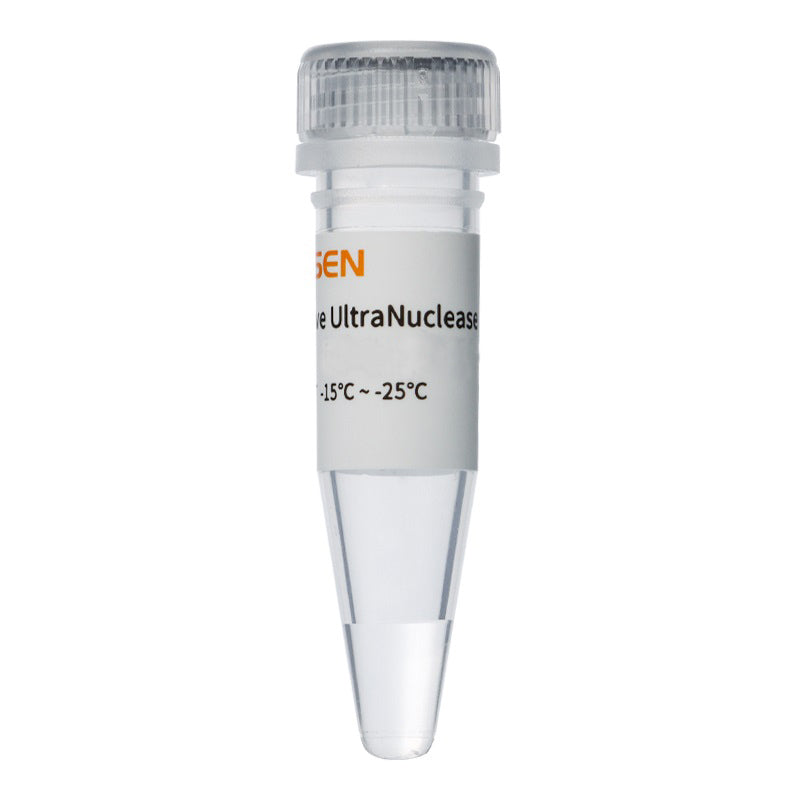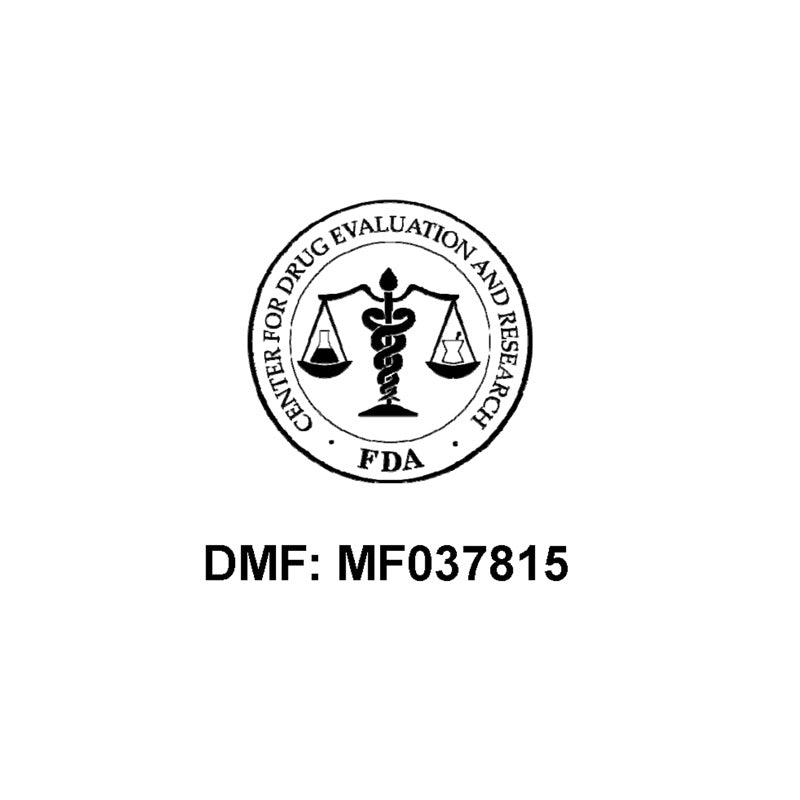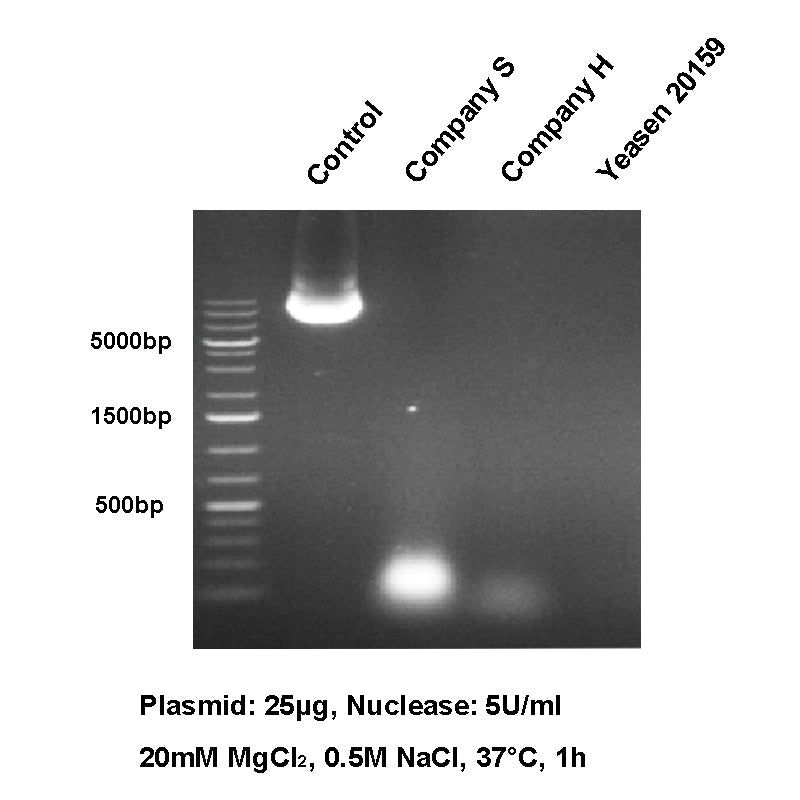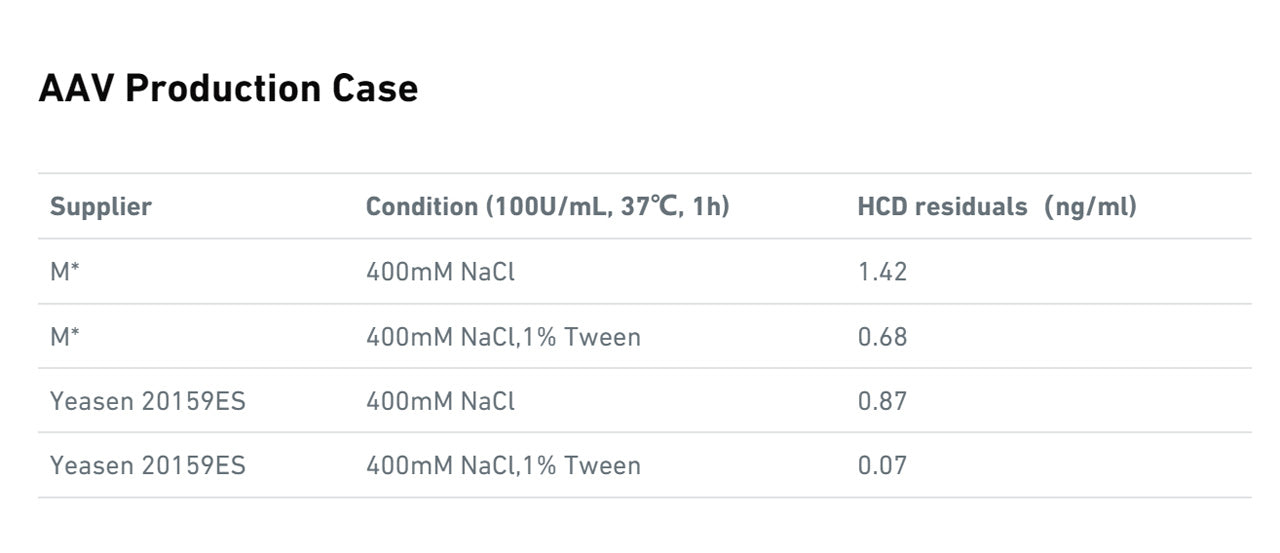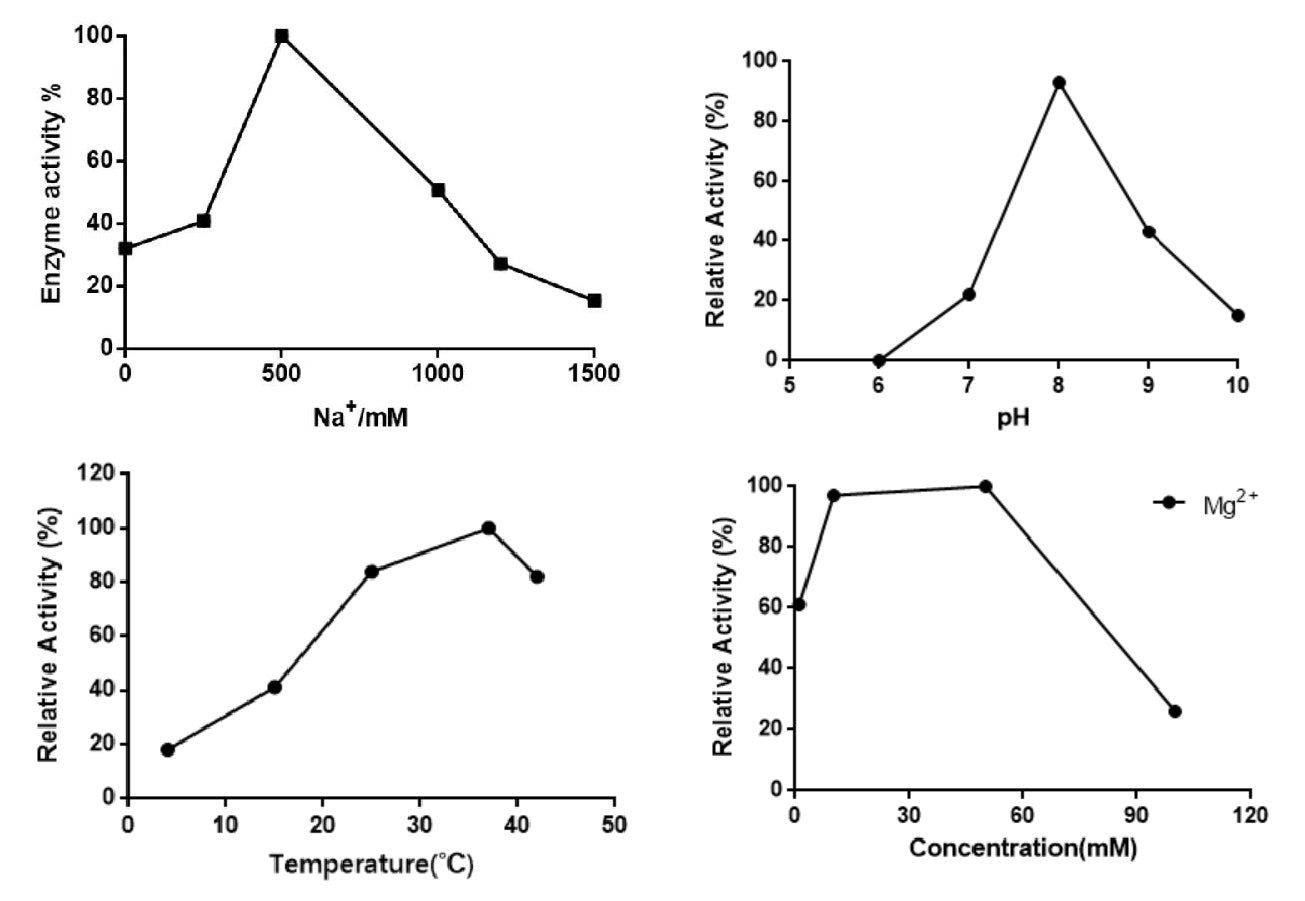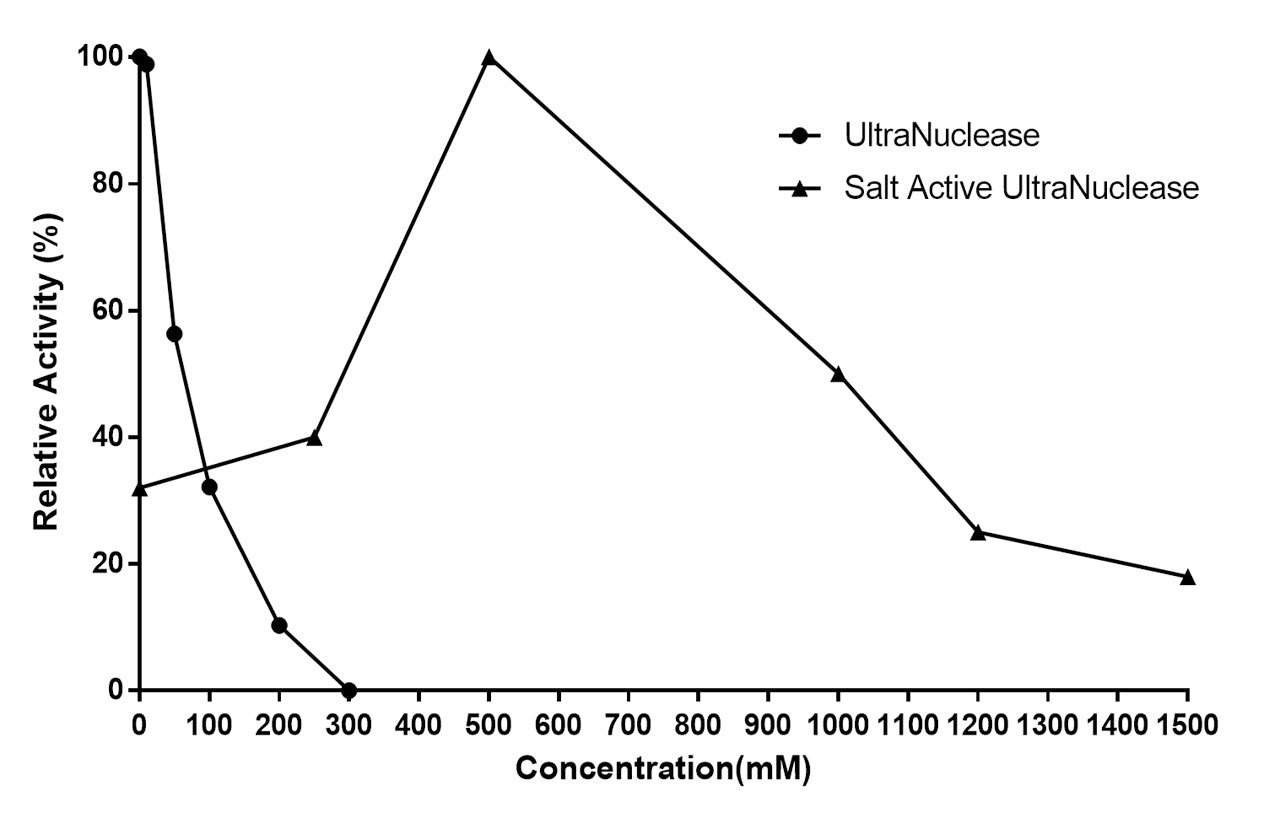Description
Salt Active UltraNuclease is a nonspecific endonuclease and has optimum activity at high salt concentration. Salt can play an important role in minimizing aggregation of protein or virus, which would be helpful for dissociation of DNA & RNA from proteins or other cellular components. In high salt conditions, enzymes are more likely to access the released DNA & RNA and degrade them. Nuclease which has high activity at high salt would be more effective to improve purification processes. The Salt Active UltraNuclease can be used to reduce the viscosity of cell supernatant and cell lysate, increase purification efficiency in high salt condition.
The enzyme can also reduce host nucleic acid residues to pg-grade, improving the performance and safety of biological products of applications including virus purification, vaccine manufacturing, and protein/polysaccharide pharmaceutical manufacturing.
Features
High Activity in High-Salt Conditions: Maintains optimal enzyme activity even at 500 mM salt concentration.
Enhanced Viral Yield: High-salt tolerance reduces AAV particle aggregation, improving virus recovery.
Reliable Product Quality: GMP-grade, animal-free, and antibiotic-free.
Regulatory Support: DMF filing completed (MF037815).
High Purity: ≥98% purity ensures consistent performance.
Low Endotoxin: Suitable for sensitive applications.
Compatible with ELISA Kits: Fully supported for downstream ELISA-based analysis.
Specification
|
Expression Host |
Recombinant, expressed in Escherichia coli |
|
Molecular Weight |
24.7 kDa |
|
Isoelectric point |
9.61 |
|
Purity |
≥ 99% |
|
Enzyme activity |
250-300 U/μL |
|
Specific activity |
≥3×105 U/mg |
|
Protein purity (SEC-HPLC) |
≥99% |
|
Bacterial endotoxins(gel-clot) |
<0.25 EU/1000U |
|
Host Protein Residue(ELISA) |
<10 ppm(μg/mL) |
|
Optimum Temperature |
37°C (operating range 0-42°C) |
|
Cofactor |
1-10 mM Mg2+ |
|
Storage Buffer |
25 mM Tris-HCl,5 mM MgCl2,500 mM NaCl,50% glycerol |
|
Unit Definition |
The definition of one activity unit (U) is the amount of enzyme that causes a △A260=1.0 in 30 minutes at 37℃ in the excess of substrate at the certain condition. |
Figures
1. Robust Activity in High-Salt Environments

Figure 1. Enzyme activity under high-salt conditions.
(A). UltraNuclease maintains robust activity in high-salt environments, showing maximum activity at 500 mM salt.
(B). Compared with Supplier M*, Yeasen UltraNuclease (Cat#20159ES) demonstrated lower HCD residuals, particularly under 400 mM NaCl with 1% Tween.
2. Efficient Nucleic Acid Removal: AAV Production Case
|
Kit |
Condition (100U/mL, 37℃, 1 h) |
HCD residuals(ng/mL) |
|
Supplier M* |
400mM NaCl |
1.42 |
|
Supplier M* |
400mM NaCl, 1% Tween |
0.68 |
|
Yeasen 20159ES |
400mM NaCl |
0.87 |
|
Yeasen 20159ES |
400mM NaCl, 1% Tween |
0.07 |
Compared with Supplier M*, Yeasen UltraNuclease (Cat#20159ES) demonstrated lower HCD residuals, particularly under 400 mM NaCl with 1% Tween.
3. Recommended operating conditions
|
Condition |
Optimal |
Effective |
|
Mg2+/Mn2+ |
10~50 mM |
1~100 mM |
|
pH |
8 |
6.5~10 |
|
Temperature |
37℃ |
4~42℃ |
|
Na+/K+ |
500 mM |
300~1200 mM |
4. Recommended Usage
|
Condition |
Suggested usage |
|
Protein |
100 U/mL |
|
Cell lysate |
500 U/mL |
|
Cell extract |
1000 U/mL |
|
Viscosity reduction |
50 U/mL |
5. Strong stability

Figure 2. Stability of UltraNuclease.
(A) Enzyme activity remained unchanged after 4 weeks of storage at –20 °C and 4 °C, and after 2 weeks at 37 °C.
(B) Enzyme activity was unaffected after 10 freeze–thaw cycles between –80 °C and –25 °C.
Shipping and Storage
The product should be stored at -25 ~ -15℃ for two years. If the product is opened and has been stored at 4℃ for more than one week, we recommend filtering the product to prevent microbial contamination.
Documents:
Safety Data Sheet
Payment & Security
Your payment information is processed securely. We do not store credit card details nor have access to your credit card information.
Inquiry
You may also like
FAQ
The product is for research purposes only and is not intended for therapeutic or diagnostic use in humans or animals. Products and content are protected by patents, trademarks, and copyrights owned by Yeasen Biotechnology. Trademark symbols indicate the country of origin, not necessarily registration in all regions.
Certain applications may require additional third-party intellectual property rights.
Yeasen is dedicated to ethical science, believing our research should address critical questions while ensuring safety and ethical standards.

